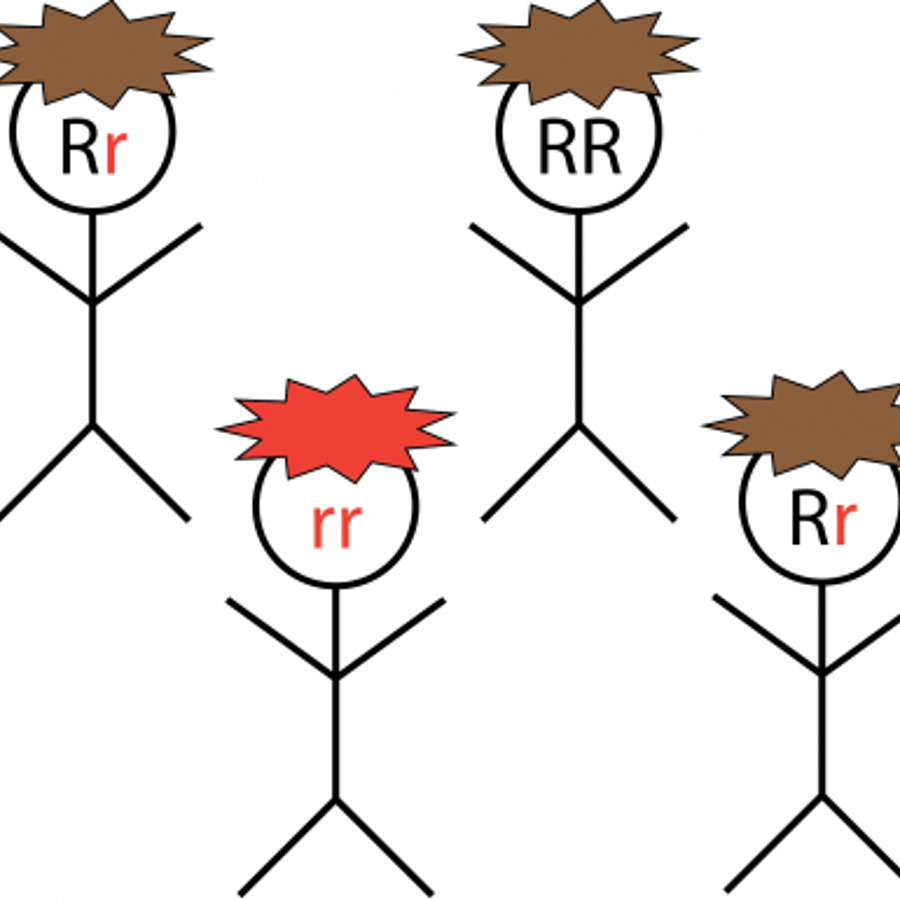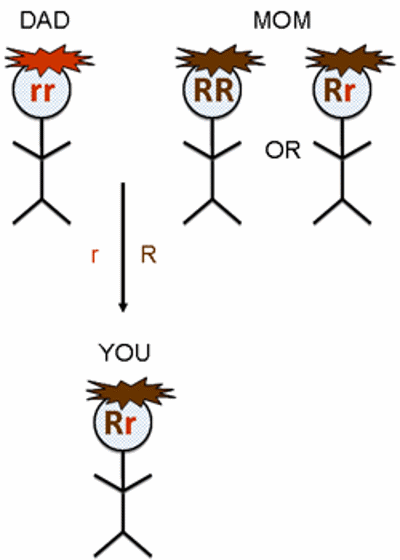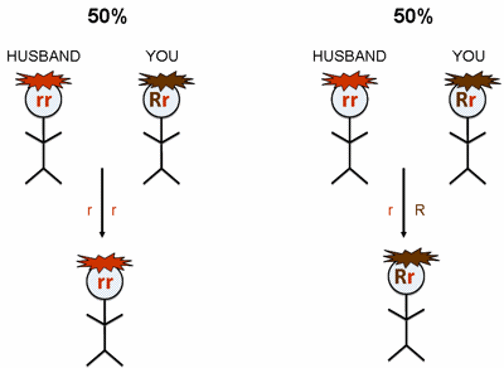
My husband has red hair, and my father did too. What are the chances we’ll have a redhead?
November 14, 2012

- Related Topics:
- Hair color,
- Red hair,
- Pigmentation traits,
- Carrier,
- Dominant and recessive
A curious adult from South Carolina asks:
"I am pregnant and I was curious on the probability that our son will have red hair. My husband has bright red hair, and so did his mom. My grandmother, father and all my aunts and great grandmother had fire red hair while young. I have brownish-red hair. I would just like to know what our odds are."
Usually these questions are tough to answer but not this time. You (and I) are lucky enough to have all the right pieces in place to answer the question. Because your husband and your dad have red hair, I can say pretty confidently that each of your kids has around a 50% chance for red hair.
This is so easy to figure out because we can figure out what red hair genes you and your husband have. As I’ll show below, with that information in hand, figuring out your kids’ chances is a snap.
And this kind of analysis isn’t restricted to just red hair. What I talk about here will work for blue eyes, green eyes, O blood type and any other simple recessive traits.
What I’ll do for the rest of the answer is show how I came up with the 50% number. It has to do with the fact that we get one copy of each of our genes from each parent and that some traits can stay hidden.
Crouching Traits, Hidden Versions
Genes are pieces of DNA that each have the instructions for one small part of you. So there is a gene that determines whether or not you’ll have brown eyes, another that determines green eyes, still another that determines whether or not you’ll have red hair and so on for each of your other 20,000 or so genes. It is the red hair gene we are obviously interested in here.
The key gene involved in red hair is called MC1R. It comes in two versions that we will call "not-red" and "red." For reasons that I’ll explain in a bit, I’ll call the not-red version R and the red version r.
We all have two sets of most of our genes — one set from mom and the other from dad. This means we have two copies of the MC1R gene too.
So we have two copies of the MC1R gene and it comes in two versions. Here are the three possible combinations of MC1R genes:
|
RR |
|
|
Rr |
|
|
rr |
|
Remembering that R means not red and r means red, two of these three combinations are easy to figure out. RR would mean not red and rr would mean red. But what about Rr?
Turns out Rr almost never has red hair (although they can have red highlights). This is because the R version of the MC1R gene is dominant over the recessive r version. R beats out r and so an Rr person does not have red hair. (In genetics, a capital letter means the dominant or winning version and a lower case letter means the recessive version.)
With this information, we can fill in our table like so:
|
RR |
Not red |
|
Rr |
Not red |
|
rr |
Red |
We need just one more bit of information to figure out the chances that your kids will have red hair. That final piece is that when we have kids, we pass just one of our copies down. And that this copy is chosen at random. (Well, I guess there were two bits of information!)
So for example, an Rr person has a 50% chance of passing down an R and a 50% chance of passing down an r each time he or she has a child. This is where your 50% comes from.
Figuring You Out
Now we are ready to figure out you and your husband’s genes. From that, we can figure out your chances for having a redhead.
Let’s do the easy one first — your husband. Since he has red hair, odds are he has two copies of the red version of the MC1R gene. He is rr.
We can figure out your genes because of your father. Since he is a redhead, he is rr. What that means for you is that he had to pass you an r…that is all he had to give. So we know you have at least one r.
But since you don’t have red hair, your other copy must be R. So you are Rr, a carrier for red hair. You do not have red hair but you can pass it down to your kids.

Now on to your kids. Your husband can only pass an r down to your kids. This means they will all have at least one r (and so will all be at least carriers for red hair).
As you can see below, each time you have a child, there is a 50% chance you will pass an R and a 50% chance you will pass an r. Combining you and your husband, we get a 50% chance for Rr (r from dad, R from mom) and a 50% chance for rr (r from both parents). So there is a 50% chance for a redhead (rr) and a 50% chance for a child without red hair (Rr).

See, that wasn’t so hard! We were saved by the fact that you had a red haired parent. As we talk about in a previous answer, if you hadn’t, things would have got a lot more complicated very quickly.
One last point. Just because each of your kids has a 50% chance for red hair, that does not mean half your kids will. If you had four kids, they could all have red hair, none of them could, or you could have some combination of kids with and without red hair. It all has to do with what copy of the MC1R gene you passed on with each pregnancy.
Remember, the copy is chosen at random and what came before doesn’t affect what comes after. If you had three redheads, your chances for a redhead in the next pregnancy would still be 50%. Because your chances for passing an r are still 50%.
This is sort of like flipping a coin. Just because you get heads, that does not affect the next flip. There is still a 50% chance for heads and a 50% chance for tails. Just like your MC1R versions!

Author: Dr. D. Barry Starr
Barry served as The Tech Geneticist from 2002-2018. He founded Ask-a-Geneticist, answered thousands of questions submitted by people from all around the world, and oversaw and edited all articles published during his tenure. AAG is part of the Stanford at The Tech program, which brings Stanford scientists to The Tech to answer questions for this site, as well as to run science activities with visitors at The Tech Interactive in downtown San Jose.
 Skip Navigation
Skip Navigation
